Page 49 of 86
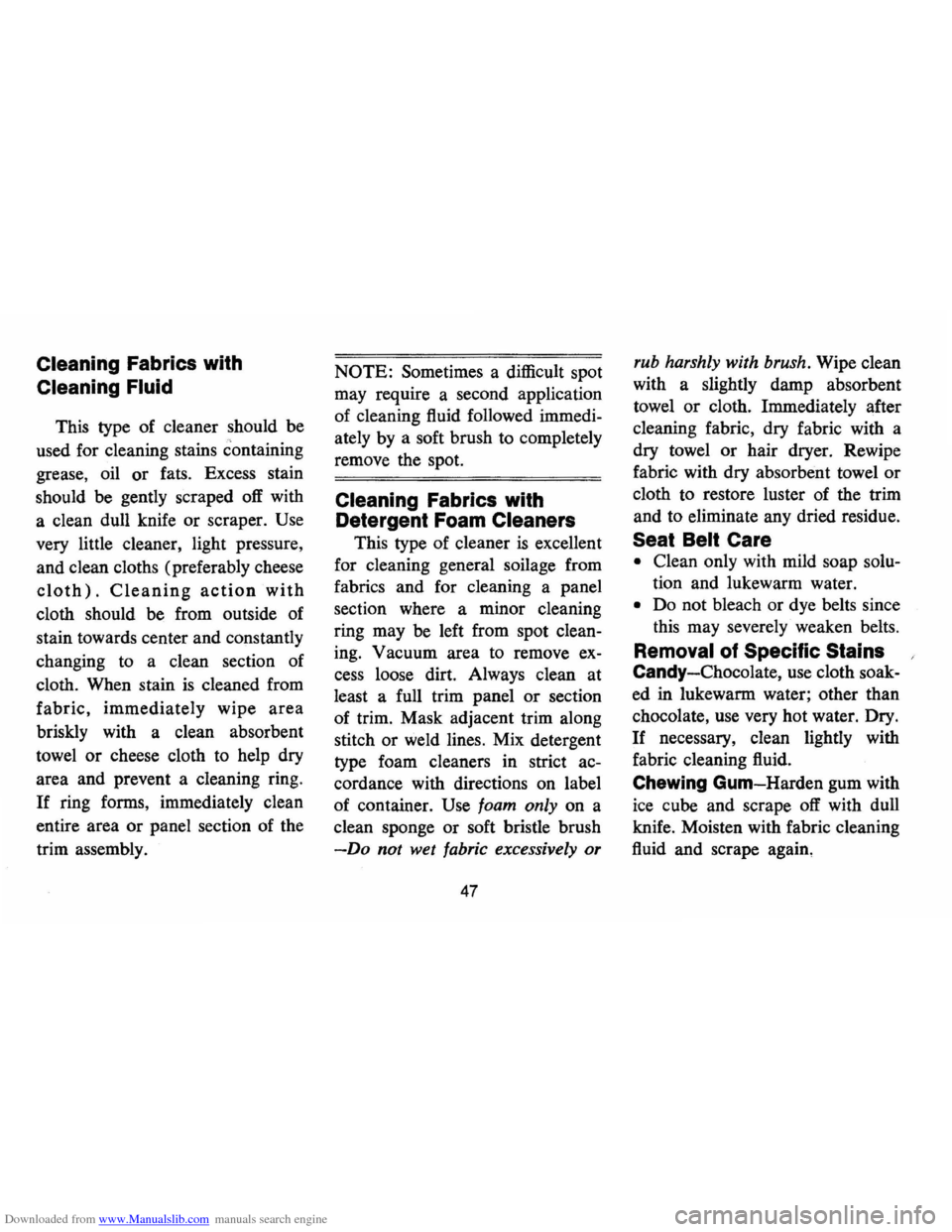
Downloaded from www.Manualslib.com manuals search engine Cleaning Fabrics with
Cleaning
Fluid
This type of cleaner should be
used for cleaning stains containing
grease, oil or fats. Excess stain
should be gently scraped off with
a clean dull knife or scraper.
Use
very little cleaner, light pressure,
and clean cloths (preferably cheese
cloth). Cleaning action with
cloth should be from outside of
stain towards center and constantly
changing to a clean section of
cloth. When stain
is cleaned from
fabric, immediately wipe
area
briskly with a clean absorbent
towel or cheese cloth to help dry
area and prevent a cleaning ring.
If ring forms, immediately clean
entire area or panel section of the
trim assembly.
NOTE: Sometimes a difficult spot
may require a second application
of cleaning fluid followed immedi
ately by a soft brush to completely
remove the spot.
Cleaning Fabrics with
Detergent Foam Cleaners
This type of cleaner is excellent
for cleaning general soilage from
fabrics and for cleaning a panel
section where a minor cleaning
ring may be left from spot clean
ing. Vacuum area to remove ex
cess loose dirt. Always clean at
least a full trim panel or section
of trim. Mask adjacent trim along
stitch or weld lines. Mix detergent
type foam cleaners in strict ac
cordance with directions on label
of container.
Use foam only on a
clean sponge or soft bristle brush
-Do not wet fabric excessively or
47
rub harshly with brush. Wipe clean
with a slightly damp absorbent
towel or cloth. Immediately after
cleaning fabric, dry fabric with a
dry towel or hair dryer. Rewipe
fabric with dry absorbent towel or
cloth to restore luster of the trim
and to eliminate any dried residue.
Seat Belt Care
• Clean only with mild soap solu
tion and lukewarm water.
• Do not bleach or dye belts since
this may severely weaken belts.
Removal of Specific Stains
Candy-Chocolate, use cloth soak
ed in lukewarm water; other than
chocolate, use very hot water. Dry.
If necessary, clean lightly with
fabric cleaning fluid.
Chewing Gum-Harden gum with
ice cube and scrape off with dull
knife. Moisten with fabric cleaning
fluid and scrape again,
Page 50 of 86
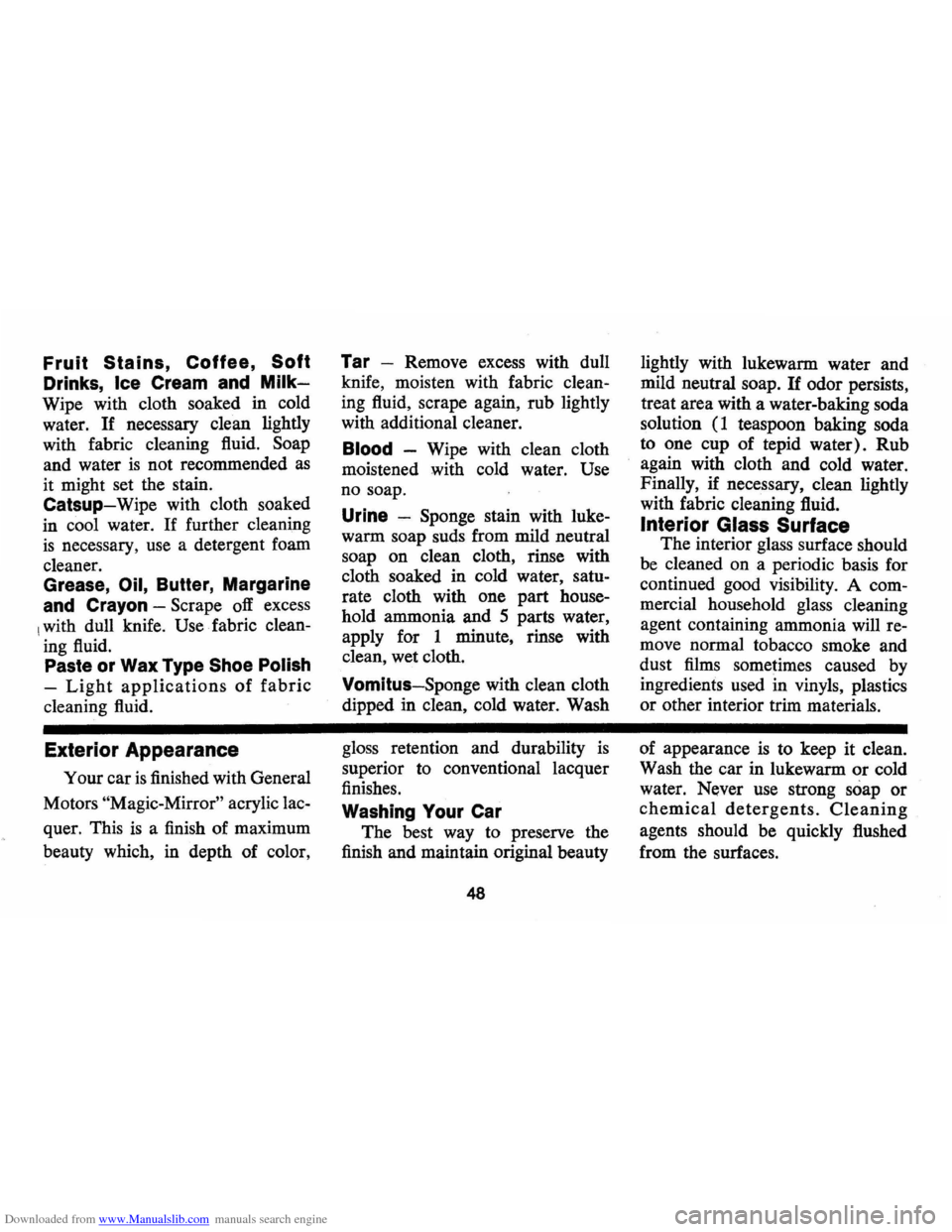
Downloaded from www.Manualslib.com manuals search engine Fruit Stains, Coffee, Soft
Drinks, Ice Cream and Milk
Wipe with cloth soaked in cold
water.
If necessary clean lightly
with fabric cleaning fluid.
Soap
and water is not recommended as
it might set the stain .
Catsup-Wipe with cloth soaked
in cool water.
If further cleaning
is necessary, use a detergent foam
cleaner.
Grease, Oil , Butter, Margarine
and Crayon -Scrape off excess
I with dull knife. Use fabric clean
ing fluid.
Paste or Wax Type Shoe Polish
-Light applications of fabric
cleaning fluid.
Exterior Appearance
Your car is finished with General
Motors
" Magic-Mirror" acrylic lac
quer. This
is a finish of maximum
beauty which, in depth of color,
Tar -Remove excess with dull
knife, moisten with fabric clean
ing fluid, scrape again, rub lightly
with additional cleaner.
Blood -Wipe with clean cloth
moistened with cold water.
Use
no soap.
Urine -Sponge stain with luke
warm soap suds from mild neutral
soap on clean cloth, rinse with
cloth soaked in cold water, satu
rate cloth with one part house
hold ammonia and 5 parts water,
apply for 1 minute, rinse with
clean, wet cloth.
Vomitus-Sponge with clean cloth
dipped in clean, cold water. Wash
gloss retention and durability
is
superior to conventional lacquer
finishes.
Washing Your Car
The best way to preserve the
finish and maintain original beauty
48
lightly with lukewarm water and
mild neutral soap.
If odor persists,
treat area with a water-baking soda
solution (1 teaspoon baking soda
to one cup of tepid water). Rub
again with cloth and cold water.
Finally, if necessary, clean lightly
with fabric cleaning fluid.
Interior Glass Surface
The interior glass surface should
be cleaned on a periodic basis for
continued good visibility. A com
mercial household glass cleaning
agent containing ammonia will re
move normal tobacco smoke and
dust
films sometimes caused by
ingredients used in vinyls, plastics
or other interior trim materials.
of appearance
is to keep it clean.
Wash the car in lukewarm or cold
water . Never use strong
soap or
chemical detergents. Cleaning
agents should be quickly flushed
from the surfaces.
Page 51 of 86
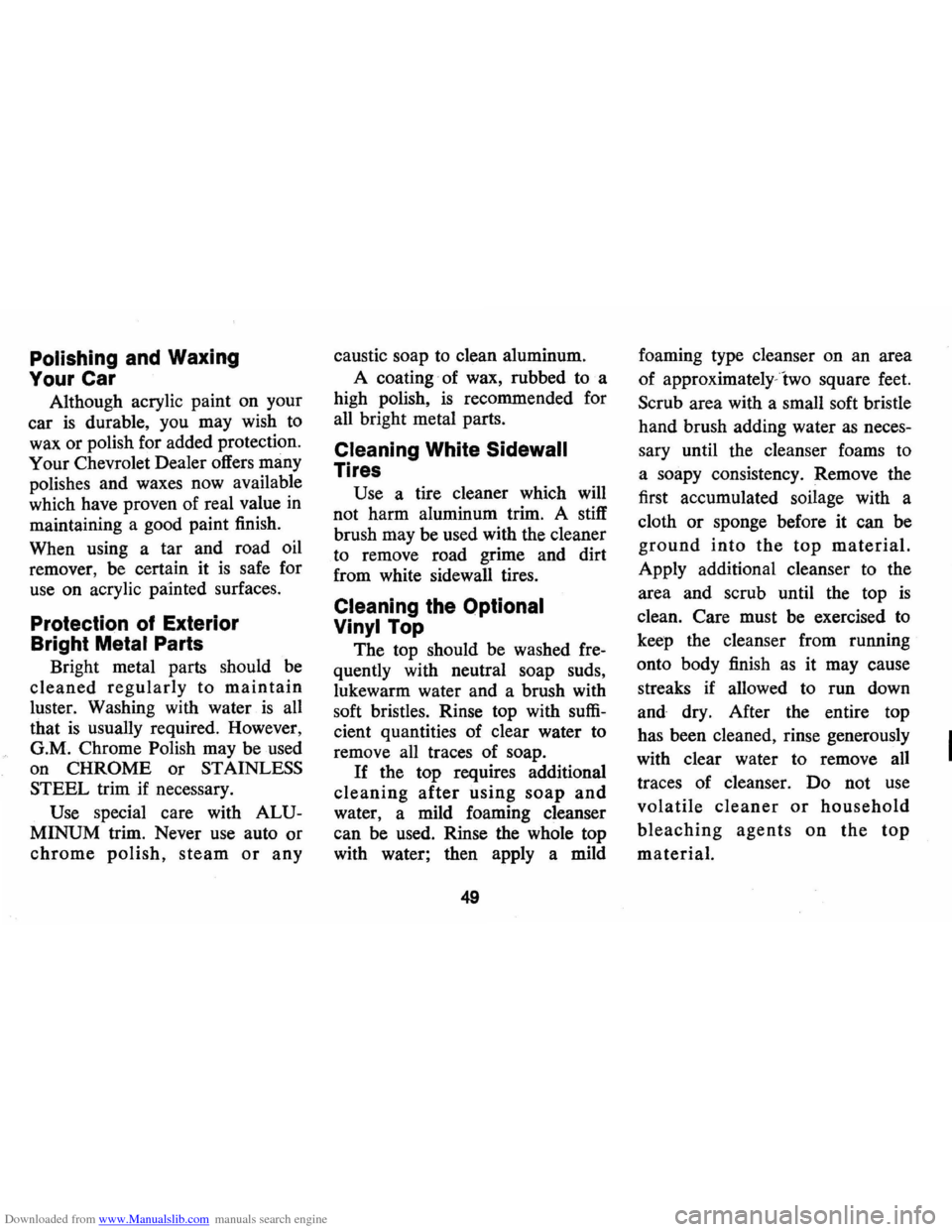
Downloaded from www.Manualslib.com manuals search engine Polishing and Waxing
Your Car
Although acrylic paint on your
car
is durable, you may wish to
wax or polish for added protection.
Your Chevrolet Dealer offers many
polishes and waxes now available
which have proven of real value
in
maintaining a good paint finish.
When using a tar and road oil
remover, be certain it
is safe for
use on acrylic painted surfaces.
Protection of Exterior
Bright
Metal Parts
Bright metal parts should be
cleaned regularly to maintain
luster. Washing with water is all
that
is usually required. However,
G.M. Chrome
Polish may be used
on CHROME or STAINLESS
STEEL
trim if necessary.
Use special care with ALU
MINUM trim. Never use auto or
chrome polish, steam or any caustic
soap to clean aluminum.
A coating of wax, rubbed to a
high polish,
is recommended for
all bright metal parts.
Cleaning White Sidewall
Tires
Use a tire cleaner which will
not harm aluminum trim. A stiff
brush may be used with the cleaner
to remove road grime and dirt
from white sidewall tires.
Cleaning the Optional
Vinyl
Top
The top should be washed fre
quently with neutral soap suds,
lukewarm water and a brush with
soft bristles. Rinse top with
suffi
cient quantities of clear water to
remove all traces of soap.
If the top requires additional
cleaning after using soap and
water, a mild foaming cleanser
can be used. Rinse the whole top
with water; then apply a mild
49
foaming type cleanser on an area
of approximately
--two square feet.
Scrub area with a small soft bristle
hand brush adding water
as neces
sary until the cleanser foams to
a soapy consistency. Remove the
first accumulated soilage with a
cloth or sponge before it can be
ground into the top material.
Apply additional cleanser to the
area and scrub until the top
is
clean. Care must be exercised to
keep the cleanser from running
onto body finish
as it may cause
streaks
if allowed to run down
and dry. After the entire top
has been cleaned, rinse generously
with clear water to remove all
traces of cleanser.
Do not use
volatile cleaner or household
bleaching agents on the top
material.
I
Page 52 of 86
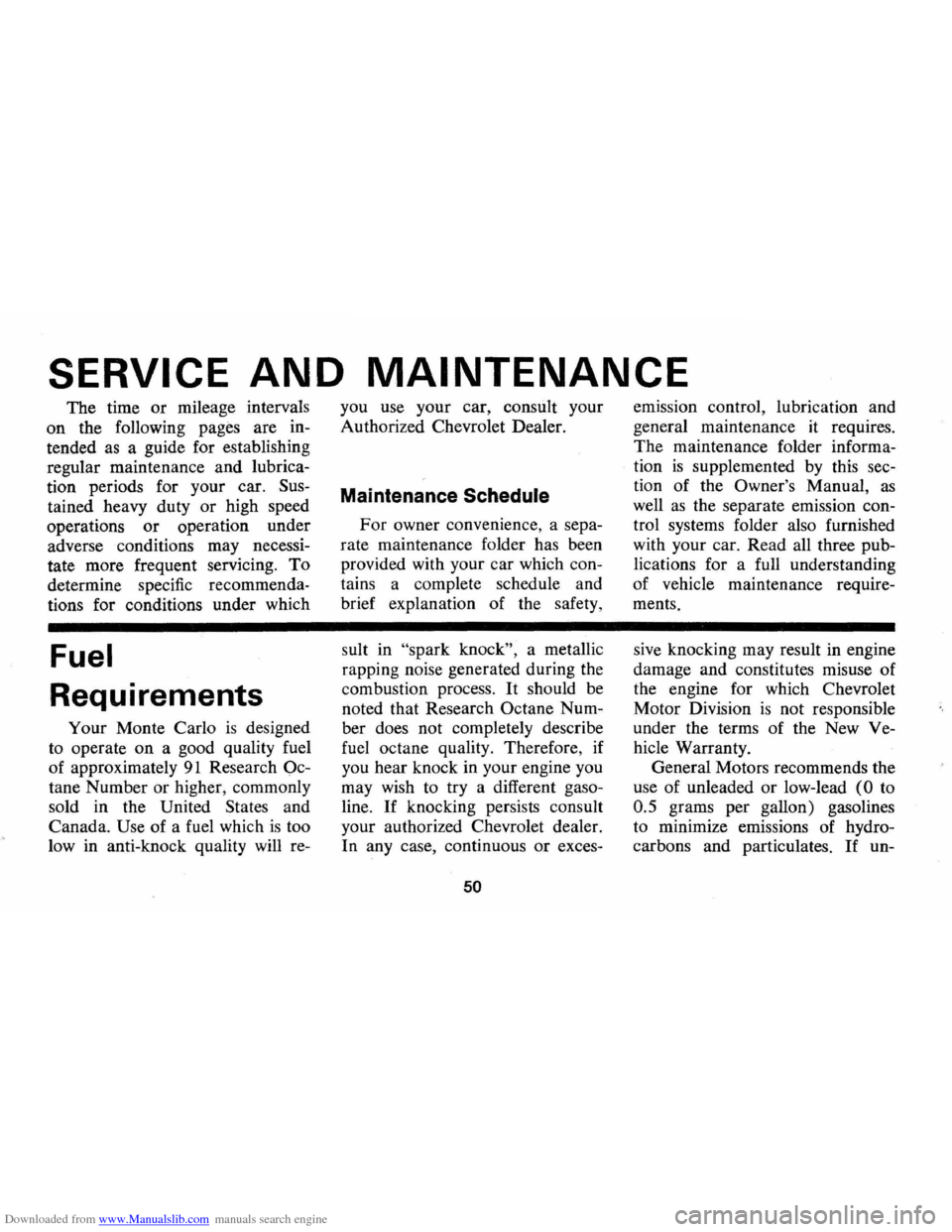
Downloaded from www.Manualslib.com manuals search engine SERVICE AND MAINTENANCE
The time or mileage intervals
on the following
pages are in
tended as a guide for establishing
regular maintenance and lubrica
tion periods for your car. Sus
tained heavy duty or high speed
operations
or operation under
adverse conditions may necessi
tate more frequent servicing.
To
determine specific recommenda
tions for conditions under which
Fuel
Requirements
Your Monte Carlo is designed
to operate
on a good quality fuel
of approximately
91 Research Oc
tane Number or higher , commonly
sold in the United States and
Canada.
Use of a fuel which is too
low in anti-knock quality will re- you
use your car, consult your
Authorized Chevrolet Dealer.
Maintenance Schedule
For owner convenience, a sepa
rate maintenance folder has been
provided with your car which con
tains a complete schedule and
brief explanation of the safety,
suIt in
"spark knock", a metallic
rapping noise generated during the
combustion process. It should be
noted that Research Octane Num
ber does not completely describe
fuel octane quality. Therefore , if
you hear knock in your engine you
may wish to try a different gaso
line.
If knocking persists consult
your authorized Chevrolet dealer.
In any case, continuous
or exces-
50
emission control, lubrication and
general maintenance it requires.
The maintenance folder informa
tion
is supplemented by this sec
tion of the Owner 's Manual,
as
well as the separate emission con
trol systems folder also furnished
with your car. Read all three pub
lications for a full understanding
of vehicle maintenance require
ments.
sive knocking may result in engine
damage and constitutes misuse of
the engine for which Chevrolet
Motor Division
is not responsible
under the terms of the New Ve
hicle Warranty.
General Motors recommends the
use of unleaded or low-lead
(0 to
0.5 grams per gallon) gasolines
to minimize emissions of hydro
carbons and particulates.
If un-
Page 53 of 86

Downloaded from www.Manualslib.com manuals search engine leaded or low-lead gasolines are
not available, gasolines containing
more than 0.5 grams per gallon
may be used.
In states using the Gasoline Per
formance and Information
System
of fuel designation, unleaded or
low-lead fuels having an anti-knock
designation of
"2" or higher are
recommended.
Gas Cap-The fuel tank filler cap
has a new two-step removal and
installation procedure plus a
pressure-vacuum safety relief.
valve. It is equipped with a double
set of locking tangs.
To remove:
• Rotate cap one-half tum coun
terclockwise to clear the first set
of tangs from the slots inside
the filler neck.
This, will allow
any residual pressure to escape.
• Pull the cap outward and rotate
one-quarter
tum counterclock
wise to clear second set of tangs
and remove the cap.
• To install, reverse this pro
cedure.
NOTE: If this cap requires a re
placement, only a cap with these
same features should be used. Fail
ure to use the correct cap can
result in a serious malfunction of
the system. Correct replacement
caps may be obtained from
your
authorized Chevrolet Dealer.
Engine Oil and Filter
Recommendations
• Use only SE engine oil.
• Change oil each 4 months or
6,000 miles. If more than 6,000
miles are driven in a 4-month
period, change oil each
6,000
miles.
• Change oil each 2 months or
3,000 miles, whichever occurs
51
first, under the following con
ditions:
- driving in dusty conditions
- trailer pulling
- extensive idling
- short-trip operation
at freez-
ing temperatures (engine not
thoroughly warmed-up).
• Operation in dust storms may
require an immediate oil change.
• Replace the oil filter at the first
oil change, and every second oil
change thereafter.
AC oil filters
provide excellent engine pro
tection.
See your Chevrolet dealer for
advice
on the frequency of oil and
filter changes under unusual driv
ing conditions.
The above recommendations
apply to the first change as well as
subsequent oil changes. The oil
change interval for your Monte
Carlo engine
is based on the use of
Page 54 of 86
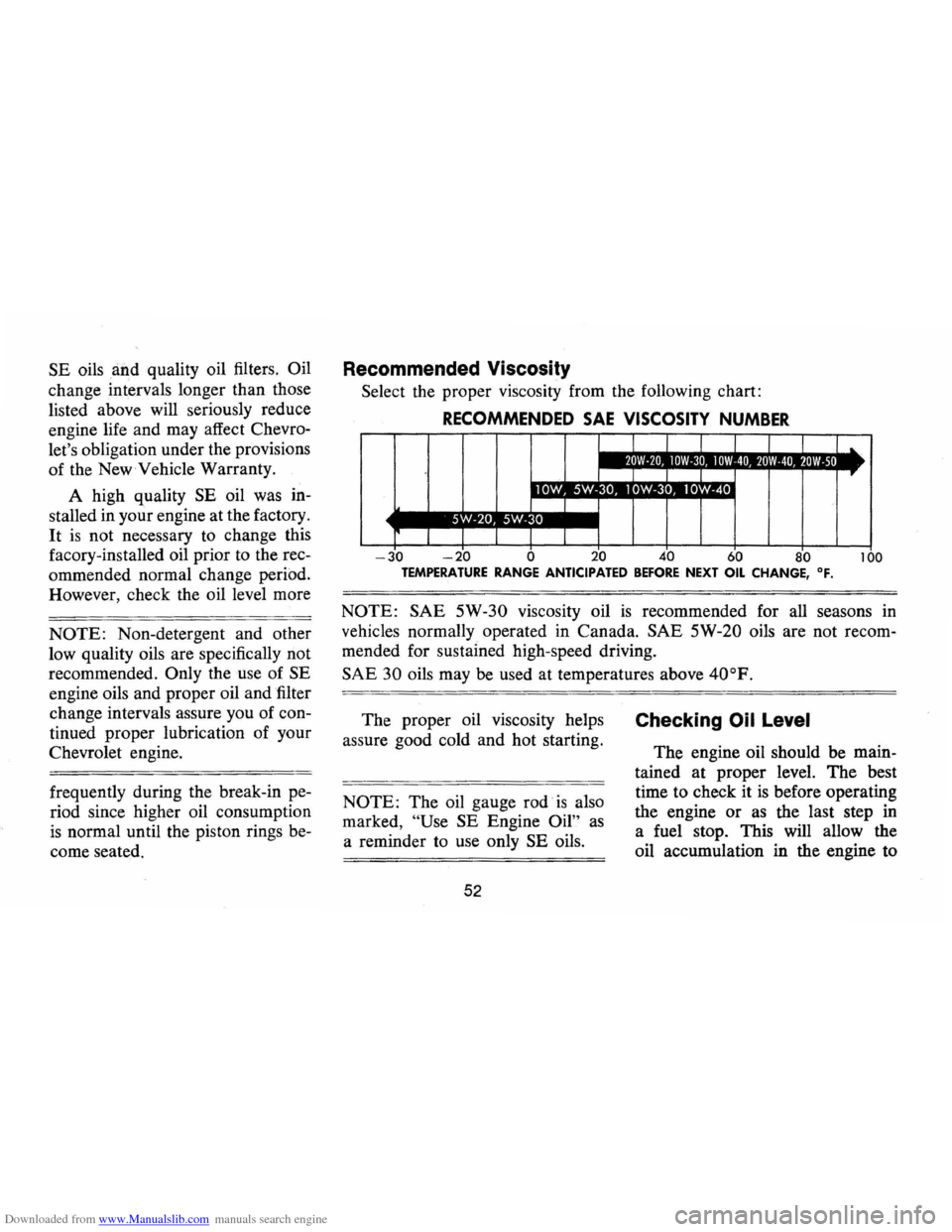
Downloaded from www.Manualslib.com manuals search engine SE oils and quality oil filters. Oil
change intervals longer than those
listed above will seriously reduce
engine life and may affect Chevro
let's obligation under the provisions
of the New Vehicle Warranty.
A high quality
SE oil was in
stalled in your engine at the factory.
It is not necessary to change this
facory-installed oil prior
to the rec
ommended normal change period.
However, check the oil level more
NOTE: Non-detergent and other
low quality oils are specifically not
recommended.
Only the use of SE
engine oils and proper oil and filter
change intervals assure you of con
tinued proper lubrication of your
Chevrolet engine.
frequently during the break-in pe
riod since higher oil consumption
is normal until the piston rings be
come seated.
Recommended Viscosity
Select the proper viscosity from the following chart:
RECOMMENDED SAE VISCOSITY NUMBER
I ,.
.... ~.-."'). ... .II ••• :.; I
-30 -20 0 20 40 60 80 100 TEMPERATURE RANGE ANTICIPATED BEFORE NEXT OIL CHANGE, OF.
NOTE: SAE 5W-30 viscosity oil is recommended for all seasons in
vehicles normally operated in Canada.
SAE 5W-20 oils are not recom
mended for sustained high-speed driving.
SAE 30 oils may be used at temperatures above 40oP.
The proper oil viscosity helps
assure good cold and hot starting.
NOTE: The oil gauge rod is also
marked,
"Use SE Engine Oil" as
a reminder to use only SE oils.
52
Checking Oil Level
The engine oil should be main
tained at proper level. The best
time to check it
is before operating
the engine or
as the last step in
a fuel stop. This will allow the
oil accumulation in the engine to
Page 55 of 86
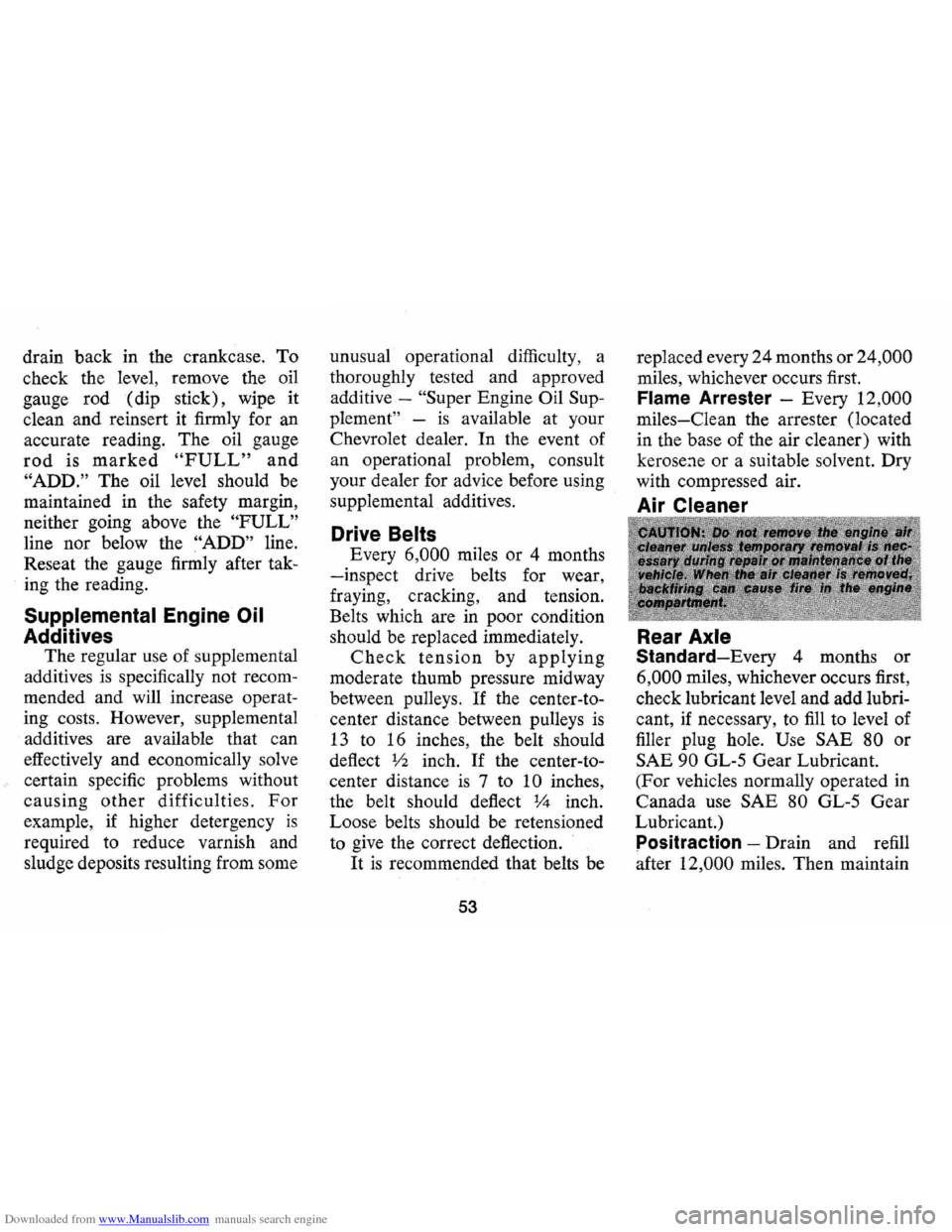
Downloaded from www.Manualslib.com manuals search engine drain back in the crankcase. To
check the level, remove the oil
gauge rod (dip stick), wipe
it
clean and reinsert it firmly for an
accurate reading. The oil gauge
rod is marked "FULL" and
"ADD." The oil level should be
maintained in the safety margin,
neither going above the
"FULL"
line nor below the "ADD" line.
Reseat the gauge firmly after tak
ing the reading.
Supplemental Engine Oil
Additives
The regular use of supplemental
additives
is specifically not recom
mended and will increase operat
ing costs. However, supplemental
additives are available that can
effectively and economically solve
certain specific problems without
causing other difficulties. For
example, if higher detergency is
required to reduce varnish and
sludge deposits resulting from some unusual
operational difficulty, a
thoroughly tested and approved
additive
- "Super Engine Oil Sup
plement " -
is available at your
Chevrolet dealer.
In the event of
an operational problem, consult
your dealer for advice before using
supplemental additives.
Drive Belts
Every 6,000 miles or 4 months
-inspect drive belts for wear,
fraying, cracking, and tension.
Belts which are in poor condition
should be replaced immediately.
Check tension by applying
moderate thumb pressure midway
between pulleys.
If the center-to
center distance · between pulleys
is
13 to 16 inches, the belt should
deflect
1/2 inch. If the center-to
center distance
is 7 to 10 inches ,
the belt should deflect
~ inch.
Loose belts should be retensioned
to give the correct deflection.
It
is recommended that belts be
53
replaced every 24 months or 24,000
miles, whichever occurs first.
Flame Arrester -Every 12,000
miles-Clean the arrester (located
in the base of the air cleaner) with
kerose:le or a suitable solvent. Dry
with compressed air.
Air Cleaner
Rear
Axle
Standard-Every 4 months or
6,000 miles, whichever occurs first,
check lubricant level and add lubri
cant, if necessary, to
fill to level of
filler plug hole.
Use SAE 80 or
SAE 90 GL-5 Gear Lubricant.
(For vehicles normally operated in
Canada use
SAE 80 GL-5 Gear
Lubricant.)
Positraction -Drain and refill
after
12,000 miles. Then maintain
Page 56 of 86
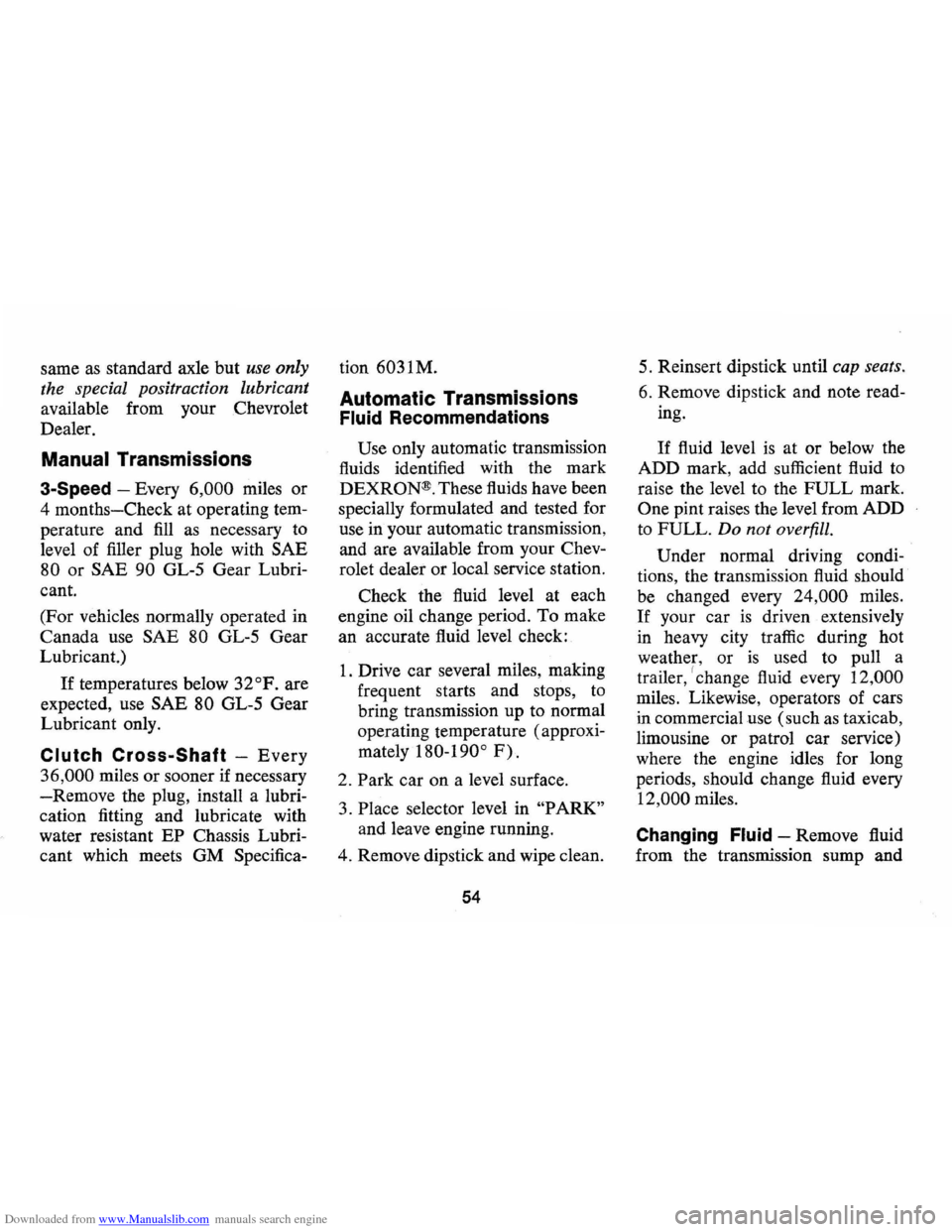
Downloaded from www.Manualslib.com manuals search engine same as standard axle but use only
the special positraction lubricant
available from your Chevrolet
Dealer.
Manual Transmissions
3-Speed -Every 6,000 miles or
4 months-Check at operating tem
perature and
fill as necessary to
level of filler plug hole with SAE
80
or SAE 90 GL-5 Gear Lubri
cant.
(For vehicles normally operated in
Canada use
SAE 80 GL-5 Gear
Lubricant.)
If temperatures below 32°F. are
expected, use
SAE 80 GL-5 Gear
Lubricant only.
Clutch Cross-Shaft -Every
36,000 miles or sooner if necessary
-Remove the plug, install a lubri
cation fitting and lubricate with
water resistant
EP Chassis Lubri
cant which meets GM Specific
a-
tion 6031M.
Automatic Transmissions
Fluid Recommendations
Use only automatic transmission
fluids identified with the mark
DEXRON ®. These fluids have been
specially formulated and tested for
use in your automatic transmission,
and are available from your Chev
rolet dealer or local service station.
Check the fluid level at each
engine oil change period. To make
an accurate fluid level check:
1. Drive car several miles, making
frequent starts and stops,
to
bring transmission up to normal
operating temperature (approxi
mately
180-190° F).
2. Park car on a level surface.
3. Place selector level in "PARK"
and leave engine running.
4. Remove dipstick and wipe clean.
54
5. Reinsert dipstick until cap seats.
6. Remove dipstick and note read
ing.
If fluid level is at or below the
ADD mark, add sufficient fluid
to
raise the level to the FULL mark.
One pint raises the level from ADD
to FULL.
Do not overfill.
Under normal driving condi
tions, the transmission fluid should
be changed every
24,000 miles.
If your car is driven extensively
in heavy city traffic during hot
weather, or
is used to pull a
trailer, {change fluid every
12,000
miles. Likewise, operators of cars
in commercial use (such
as taxicab,
limousine or patrol car service)
where the engine idles for long
periods, should change fluid every
12,000 miles.
Changing Fluid -Remove fluid
from the transmission sump and